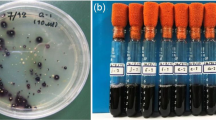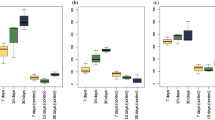Abstract
Elemental iodine is produced in Japan from underground brine (fossil salt water). Carbon steel pipes in an iodine production facility at Chiba, Japan, for brine conveyance were found to corrode more rapidly than those in other facilities. The corroding activity of iodide-containing brine from the facility was examined by immersing carbon steel coupons in “native” and “filter-sterilized” brine samples. The dissolution of iron from the coupons immersed in native brine was threefold to fourfold higher than that in the filter-sterilized brine. Denaturing gradient gel electrophoresis analyses revealed that iodide-oxidizing bacteria (IOBs) were predominant in the coupon-containing native brine samples. IOBs were also detected in a corrosion deposit on the inner surface of a corroded pipe. These results strongly suggested the involvement of IOBs in the corrosion of the carbon steel pipes. Of the six bacterial strains isolated from a brine sample, four were capable of oxidizing iodide ion (I−) into molecular iodine (I2), and these strains were further phylogenetically classified into two groups. The iron-corroding activity of each of the isolates from the two groups was examined. Both strains corroded iron in the presence of potassium iodide in a concentration-dependent manner. This is the first report providing direct evidence that IOBs are involved in iron corrosion. Further, possible mechanisms by which IOBs corrode iron are discussed.






Similar content being viewed by others
References
Elliott TC (1987) Iodine deficiency disorders. Health Technol Dir 7:1–12
Lim CP, Zhao D, Takase Y, Miyanaga K, Watanabe T, Tomoe Y, Tanji Y (2011) Increased bioclogging and corrosion risk by sulfate addition during iodine recovery at a natural gas production plant. Appl Microbiol Biotechnol 89:825–834
Sugai Y, Sasaki K, Wakizono R, Yasunori H, Higuchi Y, Muraoka N (2013) Considerations on the possibility of microbial clogging of re-injection wells of the wastewater generated in a water-dissolved natural gas field. Int Biodeterior Biodegrad 81:35–43
Sandell EB (1950) Colorimetric determination of trace metals. Wiley, New York
Casamayor EO, Schafer H, Baneras L, Pedros-Alio C, Muyzer G (2000) Identification of and spatio-temporal differences between microbial assemblages from two neighboring sulfurous lakes: comparison by microscopy and denaturing gradient gel electrophoresis. Appl Environ Microbiol 66:499–508
Muyzer G, de Waal EC, Uitterlinden AG (1993) Profiling of complex microbial populations by denaturing gradient gel electrophoresis analysis of polymerase chain reaction-amplified genes coding for 16S rRNA. Appl Environ Microbiol 59:695–700
Fuse H, Inoue H, Murakami K, Takimura O, Yamaoka Y (2003) Production of free and organic iodine by Roseovarius spp. FEMS Microbiol Lett 229:189–194
Amachi S, Muramatsu Y, Akiyama Y, Miyazaki K, Yoshiki S, Hanada S, Kamagata Y, Ban-nai T, Shinoyama H, Fujii T (2005) Isolation of iodide-oxidizing bacteria from iodide-rich natural gas brines and seawaters. Microb Ecol 49:547–557
Arakawa Y, Akiyama Y, Furukawa H, Suda W, Amachi S (2012) Growth stimulation of iodide-oxidizing α-Proteobacteria in iodide-rich environments. Microb Ecol 63:522–531
Zhao D, Lim CP, Miyanaga K, Tanji Y (2013) Iodine from bacterial iodide oxidization by Roseovarius spp. inhibits the growth of other bacteria. Appl Microbiol Biotechnol 97:2173–2182
Tsukaue Y, Takimoto Y, Yoshida K (1995) Behavior of triiodide accumulation in aqueous iodine solution. J Nucl Sci Technol 32:1192–1194
Funke F, Greger GU, Hellmann S, Bleier A, Morell W (1996) Iodine-steel reactions under severe accident conditions in light-water reactors. Nucl Eng Des 166:357–365
Wren JC, Glowa GA, Merritt J (1999) Corrosion of stainless steel by gaseous I2. J Nucl Mater 265:161–177
Beech IB, Sunner JA, Hiraoka K (2005) Microbe-surface interactions in biofouling and biocorrosion processes. Int Microbiol 8:157–168
Coetser SE, Cloete TE (2005) Biofouling and biocorrosion in industrial water systems. Crit Rev Microbiol 31:213–232
Kjellerup BV, Thomsen TR, Nielsen JL, Olesen BH, Frolund B, Nielsen PH (2005) Microbial diversity in biofilms from corroding heating systems. Biofouling 21:19–29
Muthukumar N, Rajasekar A, Ponmariappan S, Mohanan S, Maruthamuthu S, Muralidharan S, Subramanian P, Palaniswamy N, Raghavan M (2003) Microbiologically influenced corrosion in petroleum product pipelines—a review. Indian J Exp Biol 41:1012–1022
Videla HA, Herrera LK (2005) Microbiologically influenced corrosion: looking to the future. Int Microbiol 8:169–180
Dinh HT, Kuever J, Mussmann M, Hassel AW, Stratmann M, Widdel F (2004) Iron corrosion by novel anaerobic microorganisms. Nature 427:829–832
Miranda E, Bethencourt M, Botana FJ, Cano MJ, Sánchez-Amaya JM, Corzo A, García de Lomas J, Fardeau ML, Ollivier B (2006) Biocorrosion of carbon steel alloys by an hydrogenotrophic sulfate-reducing bacterium Desulfovibrio capillatus isolated from a Mexican oil field separator. Corros Sci 48:2417–2431
Dickinson WH, Caccavo F, Olesen B, Lewandowski Z (1997) Ennoblement of stainless steel by the manganese-depositing bacterium Leptothrix discophora. Appl Environ Microbiol 63:2502–2506
Ashassi-Sorkhabi H, Moradi-Haghighi M, Zarrini G (2012) The effect of Pseudoxanthomonas sp. as manganese oxidizing bacterium on the corrosion behavior of carbon steel. Mater Sci Eng C 32:303–309
Herrera LK, Videla HA (2009) Role of iron-reducing bacteria in corrosion and protection of carbon steel. Int Biodeterior Biodegrad 63:891–895
McBeth JM, Little BJ, Ray RI, Farrar KM, Emerson D (2011) Neutrophilic iron-oxidizing “Zetaproteobacteria” and mild steel corrosion in nearshore marine environments. Appl Environ Microbiol 77:1405–1412
Xu D, Li Y, Song F, Gu T (2013) Laboratory investigation of microbiologically influenced corrosion of C1018 carbon steel by nitrate reducing bacterium Bacillus licheniformis. Corros Sci 77:385–390
Uchiyama T, Ito K, Mori K, Tsurumaru H, Harayama S (2010) Iron-corroding methanogen isolated from a crude-oil storage tank. Appl Environ Microbiol 76:1783–1788
Mori K, Tsurumaru H, Harayama S (2010) Iron corrosion activity of anaerobic hydrogen-consuming microorganisms isolated from oil facilities. J Biosci Bioeng 110:426–430
Bryant RD, Jansen W, Boivin J, Laishley EJ, Costerton JW (1991) Effect of hydrogenase and mixed sulfate-reducing bacterial populations on the corrosion of steel. Appl Environ Microbiol 57:2804–2809
Iverson WP (1966) Direct evidence for the cathodic depolarization theory of bacterial corrosion. Science 151:986–988
Chatelus C, Carrier P, Saignes P, Libert MF, Berlier Y, Lespinat PA, Fauque G, Legall J (1987) Hydrogenase activity in aged, nonviable Desulfovibrio vulgaris cultures and its significance in anaerobic biocorrosion. Appl Environ Microbiol 53:1708–1710
Van Ommen Kloeke F, Bryant RD, Laishley EJ (1995) Localization of cytochromes in the outer membrane of Desulfovibrio vulgaris (Hildenborough) and their role in anaerobic biocorrosion. Anaerobe 1:351–358
Venzlaff H, Enning D, Srinivasan J, Mayrhofer KJJ, Hassel AW, Widdel F, Stratmann M (2013) Accelerated cathodic reaction in microbial corrosion of iron due to direct electron uptake by sulfate-reducing bacteria. Corros Sci 66:88–96
Linhardt P (2010) Twenty years of experience with corrosion failures caused by manganese oxidizing microorganisms. Mater Corros 61:1034–1039
Acknowledgments
This work was supported by the New Energy and Industrial Technology Development Organization (NEDO) (Grant No. P05032). We would like to thank Mr. Eiji Sasaki (Corrosion Center, Japan Society of Corrosion Engineering), Dr. Toshiaki Kodama (Nakabotec Corrosion Protecting Co., Ltd.), and Mr. Kunio Agata (Aquas Corporation) for their valuable suggestions. We also thank Mr. Shunkichi Iijima for technical assistance.
Author information
Authors and Affiliations
Corresponding author
Rights and permissions
About this article
Cite this article
Wakai, S., Ito, K., Iino, T. et al. Corrosion of Iron by Iodide-Oxidizing Bacteria Isolated from Brine in an Iodine Production Facility. Microb Ecol 68, 519–527 (2014). https://doi.org/10.1007/s00248-014-0438-x
Received:
Accepted:
Published:
Issue Date:
DOI: https://doi.org/10.1007/s00248-014-0438-x




